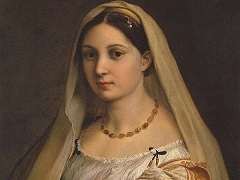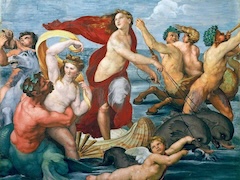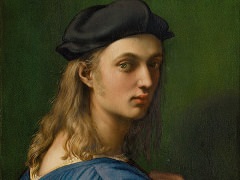La Belle Jardinière by Raphael

The various motifs in Raphael's La Belle Jardiniere blend together with remarkable success. Here, a staff and a book function as the symbols of the Passion but they are of secondary interest. The figures gaze intently at each other, and touch, the result being a denser psychological texture. Here the boy Baptist is now no longer as fully integrated into the scene as he was in the Madonna del Prato. Instead, he is a figure with which the viewer, who is being urged to worship the Redeemer, can closely identify, safe in the knowledge of the Virgin Mary's loving intercession.
In La Belle Jardinière, Raphael borrowed the Christ Child from Madonna of Bruges by Michelangelo. Raphael, however, shows the Child turning towards His mother, who is calmly sitting on a rock without having to turn her body, as she does in the Madonna del Prato. A voluminous mantle gives the figure great fullness, especially as the physical forms have become even more three-dimensional and majestic. Furthermore, showing the figure of the Virgin Mary in three-quarter profile allowed Raphael to integrate it more fully into the surrounding space. This integtation is most fully realized, however, through the use of technique of sfumato by Leonardo da Vinci, which allows a painter to model color tones through gentle gradations rather than harsh transitions. Raphael's study of Leonardo's aerial perspective also helped him to depict the broad landscape as a continuous whole - the mountains and the city lose their sharpness as they recede into the distance.
















